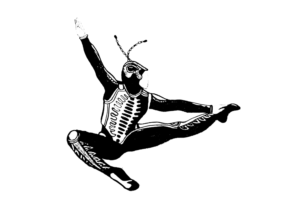
 Neah Lim springs onto the stage of the Keller Auditorium as nerves bolt through her body. Her viridescent outfit glimmers, catching eyes with its gold highlights, while the shining stage lights blind her. Lim is debuting her first company role in Oregon Ballet Theatre’s production of George Balanchine’s “The Nutcracker,” the Chinese Tea variation. Despite the exhilaration of the moment, she questions the morality of it. She wonders, “Is it right to be dancing this part?”
Neah Lim springs onto the stage of the Keller Auditorium as nerves bolt through her body. Her viridescent outfit glimmers, catching eyes with its gold highlights, while the shining stage lights blind her. Lim is debuting her first company role in Oregon Ballet Theatre’s production of George Balanchine’s “The Nutcracker,” the Chinese Tea variation. Despite the exhilaration of the moment, she questions the morality of it. She wonders, “Is it right to be dancing this part?”
The second act of a family favorite ballet, “The Nutcracker,” includes a dance, the Chinese Tea variation, that some recognize as racially offensive. The Chinese Tea variation is now frequently perceived as caricature-like and stereotypical. Lim, School of Oregon Ballet Theatre dancer, remembers choreography from the variation, she says, “We would call them chopstick fingers. I was pretty uncomfortable with it … as I learned the role, I learned the choreography more in-depth and I really saw more cultural appropriation.”
Now, ballet companies across the world are working to perform “The Nutcracker” in a culturally responsive manner.
Ballet changed incredibly when George Balanchine, choreographer and eventual founder of the New York City Ballet, moved to the United States from Russia. Balanchine had a preference for ballerinas being thin, long-legged, white women. In a 1981 New York Times article, the Balanchine body is described as “a young dancer with a small head and long legs.” Balanchine, quoted in the article, says, “‘My dancers are just good dancers, with well-trained, nice bodies.’” Balanchine’s preference influenced what many now think of as the ‘ballet body.’
The ‘ballet body’ stereotype continues to be the standard and drives a lack of diversity among professional dancers. Black dancers make up just 10% of professionals, and Asian dancers make up 6.4%, even less. It took the American Ballet Theater, one of the most prestigious ballet theaters in the United States, over 50 years to have a Black female principal dancer, with Misty Copeland being the first in 2015.
Asia Tran, a Grant student and former dancer at the School of Oregon Ballet Theatre says, “I’ve been dancing since I was three years old, I’ve always been the oddball out of every class being African-American and Asian.”
Kaelin Walker, a Texas ballet teacher, also sees the effects of a lack of diversity in the field. “I was in the Chinese Tea variation, to nobody’s surprise. There are not a lot of Asian dancers,” she says. The history of ballet means that changes are slow to come.
In 1816, Ernst Theodor Wilhelm Hoffmann authored and published the book, “The Nutcracker and the Mouse King”, the story which inspired the ballet, “The Nutcracker”. The first Nutcracker was choreographed by Marius Peptipa and Lev Ivanov and premiered on December 6, 1892, in St. Petersburg, Russia. Balanchine danced this version in 1919.
After moving to the United States Balanchine re-choreographed “The Nutcracker.” His version is the most commonly used to this day.
“The Nutcracker” follows the story of a young girl who visits the Land of Sweets, in which she is met with treats from various countries.
The Chinese Tea variation, a segment of the performance, has recently gained notoriety for its racially harmful stereotypes.
From choreography to costumes, the dance prompts a lot of discomfort. Lim shares her experience dancing the role, saying “It had a lot of head bobbing with overdone gestures and the woman bowing to the guy, it almost seems done in a submissive way.” Lim has danced the role in 2021 and 2018, the year Oregon Ballet Theatre first implemented changes in their choreography, due to concerns within dancers and audiences.
Tran also danced the role. Reflecting, she says, “Growing up, this was all I knew so I never actually thought about how Chinese tea is problematic … now, looking back, I realize it’s actually very racist.”
Beyond the choreography, the costumes worn during the variation raise questions and concerns. “I remember them face painting the role of Chinese to make them look more Asian and drawing their eyes to look more pulled back,” says Tran.
Dancers commonly wear yellowface makeup, used to imitate the characteristics of East Asian people. This includes heavy eye makeup to create the illusion of slanted eyes, white face paint, blush and more. Men wear ‘Fu Manchu’-like mustaches with tapered ends which droop to the chin in addition to the makeup.
The costuming had headpieces or chopsticks for their hair, combined with an emulation of traditional Chinese print for their dresses and pant/top set. Most often, the costumes were brightly colored silk material. Joy Rothi, a dancer at Portland Metro Arts says, “I don’t think that’s very representational, it can be offensive.”
Walker feels that the variation presents an exoticized version of being Chinese. She says, “The made-up movements, finger-pointing, in addition to a costume that not only mimicked a specific group of Chinese people’s hairstyle and dress but their facial features, yellowface, created this Western generalization of what Chinese people moved and looked like, which became a harmful stereotype.” She feels that not only is the variation an inaccurate representation of her culture, it also perpetuates harmful stereotypes.
Maggie Maierle, a Grant student and a dancer with the School of Oregon Ballet Theatre, says about dancing the Chinese tea variation, “In my soul, I was like, something is a little off … if you’re coming to see the Nutcracker and you see your culture like that you’ll be like, ‘I don’t want to come back.’ I just want everyone to see it, to have a good time. By performing, I just want to make people happy.”
Some see their culture as being misrepresented by this variation but feel pressured into complicity. Walker reflects on the impacts of the variation, saying, “Even as a child I thought, ‘Of course, I got cast in Chinese.’ I have always been proud to be Chinese-American, but I really wanted to do Spanish, Arabian, or Flowers one day. Would I be consigned to always be the Asian character?”
Outcry over the lack of racial sensitivity has led to mobilization and action. Phil Chan and Georgina Pazcoguin are the co-founders of Final Bow for Yellowface (www.yellowface.org). Their intentions with the project are to produce a more welcoming performing arts environment, expand the ways that Asian Americans are presented in ballet and to be conscious of the messages being sent to the public through dance.
Together, Chan and Pazcoguin authored a pledge, which states, “I love ballet as an art form, and acknowledge that to achieve a diversity amongst our artists, audiences, donors, students, volunteers, and staff, I am committed to eliminating outdated and offensive stereotypes of Asians (Yellowface) on our stages.” This pledge is found on their website along with the companies, schools and administrators who have signed the pledge.
“They are raising worldwide awareness of the issue that Asian dancers have known all along,” says Walker. Final Bow for Yellowface is encouraging dance companies everywhere to change their productions of “The Nutcracker.”
Changes aren’t easy. Any alterations to Balanchine’s choreography must be approved by the Balanchine Trust. The Trust was established in 1987 to preserve the integrity of Balanchine’s choreography and manage the copyrighting of his ballets. Any changes to Balanchine’s choreography or costuming must be approved by the Trust. Typically, approved changes begin at the New York City Ballet, afterwards, permission is given to other companies.
“New York City Ballet, which is a really big ballet company, was getting pushback on the Chinese tea dance. So, finally, the Balanchine Trust caught on and they changed New York City Ballet’s version. Then we got permission but we kinda had to wait for it to trickle down,” says Yukino Logan, a dancer at the School of Oregon Ballet Theatre. Logan feels like changes starting at New York City Ballet make it hard for smaller companies to push for change, they have a lesser impact in the eyes of the Trust.
After several years of push-back, in October 2018, the Trust approved specific changes to the Chinese tea variation and notified companies of the option. To some, these changes were not extreme enough.
To Logan, the changes the Trust made felt passive, as if the Trust didn’t care as much as she did. “It wasn’t a mandatory thing, which I think is frustrating that they didn’t say a definite, ‘you need to change this because it’s bad.’ They made it more of an option,” she says.
Others feel that they have no power over whether their company makes changes or not. Maierle says, “We can’t say anything. Because even if we do propose changes, it has to go through the Trust … (dancers) were like, bowing in a curtsy and (the Balanchine Trust representative) was like, ‘oh, no, no, that needs to be in sixth position (parallel feet and legs) with the arms crossed over.’ It always just comes back to the Trust.”
Now, during the first season back on stage, some see an urgency has been brought to rethinking the way ballet companies portray Asians. During COVID-19, racism against Asians rose rampantly. In 2019, hate crimes against Asians were at their highest rate in over a decade. “There’s more of a global recognition that it’s problematic. And I think that sort of sparked things … it’s starting to be controversial,” says Rothi. Despite the setbacks, changes are becoming more and more common.
Walker says, “The choreography of Petipa, Ivanov, Balanchine, etc, should be updated. While we can appreciate them for their work and honor their legacies … their idea of Chinese people was inaccurate and in today’s society, it is no longer appropriate. Now it is time to enlist Chinese choreographers to create work that embodies what it means to be both Chinese and a dancer in a respectful and truthful way.”
When instituting changes to the variation, a common place to start is costuming. This includes removing the yellowface makeup and the mustaches and changing headpieces.
Maierle says, “For choreography people can say ‘it’s historical.’ So it’s much harder to go through the process of changing it, but costuming is something that I think is a good place to start.”
While more difficult to do, dancers and companies still push for changes to the choreography. Traditional versions of the Chinese Tea variation contain pointed index fingers, which dancers call “chopstick fingers.” The Oregon Ballet Theater changed this to simple port de bras (movement of the arms and back in ballet), and other companies have done the same.
Some companies are aiming to rechoreograph the entirety of the dance. Pacific Northwest Ballet introduced a new character this year: Cricket, a dancer dressed in a colorful cricket-like costume, is now the main showcase of their Chinese Tea. This character does impressive jumps and steps meant to replace anti-Asian stereotypes. When Peter Boal, the artistic director of Pacific Northwest Ballet, requested permission from the Trust to change the choreography, he was told that the original costume sketches appeared ‘bug-like.’
Boston Ballet implemented a pas de deux (partner dance) based on traditional Chinese ribbon dances, and Colorado Ballet has changed its costumes to resemble the colors of Asian street food.
Butler University now performs the Dragon’s Beard Candy in place of the Chinese tea. Dragon’s Beard Candy is a dessert served to the emperors of China. Their choreographer, Ramón Flowers, changed the movements to reflect the essence of The Monkey King, the main character in the classical Chinese novel, “Journey to the West.”
He says, “These changes may seem minor; however, I feel that this is a major step in the right direction towards diversity, equity and inclusion.”
Other companies have hired Chinese choreographers to work with their dancers and teach them traditional Chinese steps.
Alternatively, companies like Berlin Ballet are skipping “The Nutcracker” this year to reassess their choreography.
For some, changes to “The Nutcracker” prompted anger. People cited reasons of ‘freedom of artistic expression,’ meaning they believe that dance should exist without boundaries. Others are opposed to adaptations feeling that editing the choreography is disrespectful.
Despite setbacks, as ballet moves into the future, a great deal of ballet companies are exploring the importance of cultural appreciation.
Walker says, “This needs to end … Asian people are the targets of discrimination, racial slurs and race-based violence. We cannot change our eye shape on a whim. We cannot scrub our Asian-ness away after making money from dancing in a show. Ballet companies everywhere must stop this practice.”



